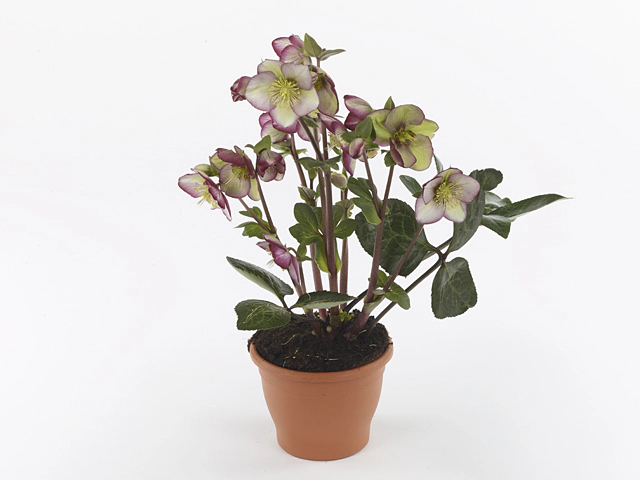Helleborus 'ET EPB 731'

| Flower type | Single |
| Leaf margin | Serrate |
| Winter hardness | Excellent (USDA-zone 1,2,3,4) |
| Flower color | White-white-NN155D; Red-dark purple red-N186D |
| Flower diameter | 7,5 - 8 cm |
| Plant height | 30 - 40 cm |
| Flowering month(s) | January; February; March; December |
| Leaf size | 20 - 25 cm |
| soil pH requirement | Alkaline (pH > 7,5); Slightly acidic (pH 4,5 - 6,5); Neutral (pH 6,5 - 7,5) |
| Light conditions | Semi-shades |
| Leaf division | Diversely compound |
| Leaf, main color | Dark green |
| Leaf colour, pattern | Unicolored |
| Flower color distribution | Marginate; Striate; Bicolored; With trace |
| Flower, secondary color(s) | Light green |
| Toxicity (if consumed) | Toxic |
| Moisture requirements | Well-drained; Moist |
| Soil type | Humus rich |
The Helleborus 'ET EPB 731', commonly known as Hellebore, is a stunning flowering plant that is sure to add beauty to any garden. With its single flowers and serrated leaf margins, it is a visually striking addition to any landscape.
One of the standout features of this plant is its excellent winter hardness. It is able to withstand even the harshest of winter conditions, making it suitable for USDA zones 1, 2, 3, and 4. This means that it can thrive in regions with extremely cold temperatures, ensuring its longevity and beauty throughout the year.
The Helleborus 'ET EPB 731' produces flowers in two different colors. The primary flower color is a pristine white, while the secondary color ranges from a dark purple-red to a rich red. This combination of colors creates a beautiful contrast that is sure to catch the eye.
The flowers of this Hellebore are quite large, with a diameter of 7.5 to 8 cm. This not only adds to their visual appeal but also makes them a great focal point in any garden. The plant itself reaches a height of 30 to 40 cm, making it perfect for borders or as a centerpiece in a flower bed.
Flowering primarily in the months of January, February, March, and December, this Hellebore adds a vibrant burst of color during the winter months when many other plants are dormant. This makes it an ideal choice for those looking to brighten up their landscapes during the colder seasons.
The foliage of the Helleborus 'ET EPB 731' is also quite impressive. The leaves are large, ranging from 20 to 25 cm in size. They have a diversely compound division, adding texture and interest to the plant. The main color of the leaves is a deep, dark green, which provides a striking contrast against the white and red flowers.
In terms of soil preference, this Hellebore can thrive in a variety of soil pH levels. It can tolerate alkaline soils with a pH greater than 7.5, slightly acidic soils with a pH between 4.5 and 6.5, as well as neutral soils with a pH range of 6.5 to 7.5. This adaptability makes it suitable for a wide range of garden settings.
When it comes to light conditions, the Helleborus 'ET EPB 731' prefers semi-shaded areas. It can thrive in areas that receive filtered sunlight or partial shade, making it an excellent choice for gardens with limited sunlight.
It is important to note that this Hellebore, like many others, is toxic if consumed. Therefore, it should be kept away from children and pets to prevent any accidental ingestion.
Moisture requirements for this Hellebore include well-drained and moist soil. It prefers soil that does not become waterlogged but retains enough moisture to keep the plant healthy. Regular watering during dry spells is essential to maintain its lush appearance.
In terms of soil type, the Helleborus 'ET EPB 731' prefers humus-rich soil. This type of soil provides the necessary nutrients for the plant to thrive and ensures its overall health and vitality.
In conclusion, the Helleborus 'ET EPB 731' is a stunning flowering plant that is well-suited to various landscapes. With its beautiful flowers, striking foliage, and adaptability to different soil and light conditions, it is a versatile and attractive addition to any garden. Its winter hardiness and ability to thrive in cold temperatures make it particularly appealing for those looking to add color and life to their gardens during the winter months.
Market availability index by month:
| Jan. | Feb. | Mar. | Apr. | May | Jun. | Jul. | Aug. | Sep. | Oct. | Nov. | Dec. |
|---|---|---|---|---|---|---|---|---|---|---|---|
| 2 | 1 | 1 | 1 | 1 | 1 | 1 | 1 | 1 | 3 | 4 | 3 |